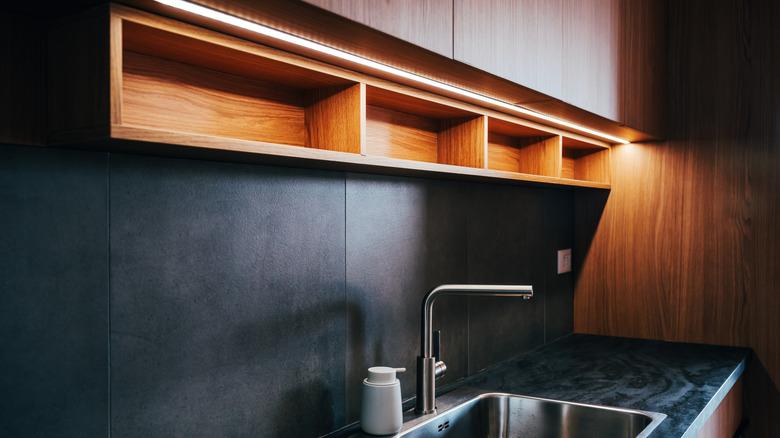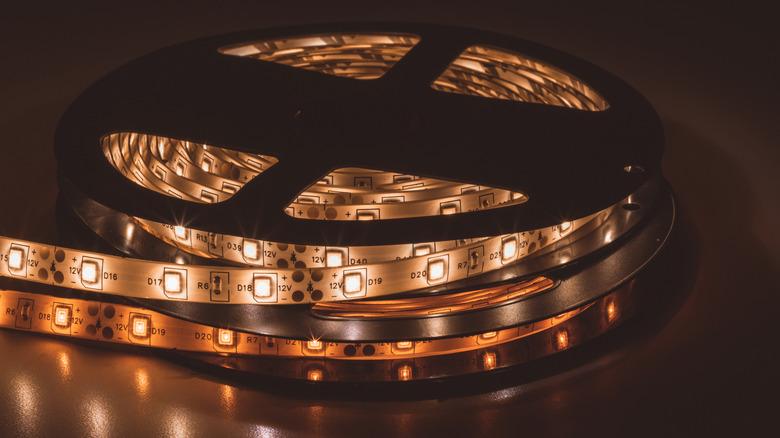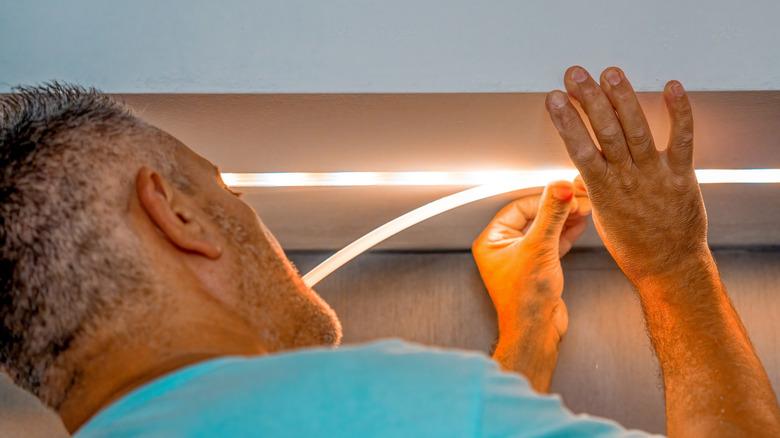The Little-Known Downsides To Using LED Light Strips Around The House
We may receive a commission on purchases made from links.
LED light bulbs have been a popular solution over the past few decades due to their energy efficiency and durability. And more recently, the low-emitting strips have also gained popularity for their unique look, adjustable color schemes, sleek design, and the fact that there are plenty of clever ways to use LED strips in your home. However, like with many other lighting choices, these strips come with their own drawbacks.
While it's true that these lights are one of the great light fixtures for brightening up your home, which highlight key areas, add low-profile lighting to small nooks and crannies, or quickly change for mood lighting on ceilings and floorboards, it's important to know about the downsides as well. Whether it's higher upfront and installation costs, difficulty with replacing bulbs, patchy lighting, or a more complicated removal process, this lighting alternative option may come with more obstacles than you realize.
Installation costs and long-term use
One of the most popular benefits of using LED lighting is its efficiency, which allows households to spend less on their energy bills and avoid having to change bulbs as often. However, when looking into buying these strips, the upfront purchasing cost is certainly something to consider. In order to properly install them, several additional elements are needed. There are several items you need to consider for installing LED lights properly. These can include solderless wire clamps ($9.99 for a pack of 25); if your LED strips don't come with one, a compatible controller for changing colors or dimming ($4.99 on Amazon), and even a power supply ($15.99, also on Amazon). One solution for making the initial cost more feasible is to install the LEDs in sections. Completing one wall or section at a time will allow you to finish the look as your budget allows, while still adding your desired depth and warmth to any room. Some stick-and-go LED strips are also available for a lower cost, and strips compatible with smart devices can add the perfect finishing touch to any room. It is important to check the product details to ensure no other equipment is required.
Another drawback mentioned by those who have owned LED light strips is that they're prone to not working correctly or at all over long periods of use. Light Supplier notes that they can fall victim to dimming in a phenomenon called 'luminous decay.' Sustained usage can also sometimes lead to patchiness, where some or all of the bulbs in a section lose brightness, resulting in an uneven look. This irregularity can often be a result of unmatched voltage, meaning that the voltage coming from the power socket is not suited to the voltage required by the LEDs. However, this can often be avoided by purchasing a transformer that converts the voltage of the socket into the amount needed for them.
Potential damage to walls or surfaces
Finally, a considerable drawback to these strip lights is the glue which is used to attach them to walls or tiles. One drawback is that the adhesive may not even work (depending on, among other considerations, the material which you are attempting to hanging the LED lights from). Additionally, if you are able to get the adhesive to stick, it can often be difficult to remove, potentially causing the underlying paint, finish, veneer, or wallpaper to peel off, leaving unattractive blank spots in its wake.
However, there are some helpful tips to aid you in removing the sticky substance to avoid potentially damaging your walls and surfaces. First, you need to thoroughly clean the surface you plan on adhering it to. For your LED strips, a good place to start is by dipping a cloth in warm, soapy water and pressing the mixture onto the adhesive for a couple of minutes. This may help the residue relax so that you can gently scrape it off with a flat object such as a dinner knife, scraper, or even a credit card. Another option is to heat up the adhesive with a hair dryer; this will help the material to detach slightly from the wall, allowing you to peel it away more easily.


